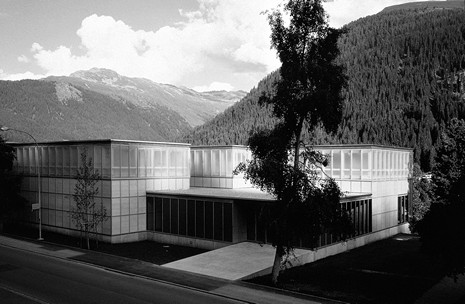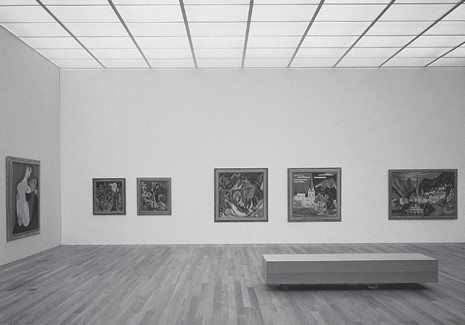Description
The occasion for the erection of this museum in Davos in Switzerland was supplied by a donation of circa 400 works by the German Expressionist Ernst Ludwig Kirchner (1880-1938), who spent the last 21 years of his life there. The first large project by the Zurich architects Annette Gigon and Mike Guyer started from the basic idea of counterbalancing Kirchner’s expressive, colour-intensive pictorial vocabulary with a purist architectural language of reserved rigour. Four exhibition rooms (three of them the same size, 18 x 9 x 4.75 metres, and a smaller one of 11 x 9 x 4.75 metres) as cubic blocks linked to each other by the lower entrance and access hall determine the museum’s appearance, which functions like a paraphrase of the loosely jumbled flat roofs of Davos. However, this well-thought-out ensemble is marked above all by its glass cladding articulated by chromed steel bands. In part opaque and shimmering matte, in part transparent and reflecting, it covers the entire building like an external skin (even the flat roofs are covered with shards of glass instead of the usual gravel).
The interior lighting significantly determines the design of the building structure as a whole. In order to illuminate the collection rooms even in the winter months by means of a squared skylight extending from wall to wall, a well-proportioned glass housing was set over their volumes. This enables natural overhead lighting for the most part even when the snow is deep, by means of the lateral light regulated with the aid of lamellas (which can be infinitely variably supplemented by artificial light whenever necessary). The insulation necessary as a prerequisite for the exhibition rooms – their layout also had to take into account the existing trees – determines both the ground plan and the lower height of the corridor-like access hall to which visitors return again and again, and from which they can see outside. Exposed concrete and reduced lighting demonstratively differentiate this circulation area (which is not at all suitable for hanging pictures) from the white collection rooms with parquet floors, each accessed individually via doorless openings.
Faces. Journal d’architectures 26/1992-93, pp. 15-19 (Dorothee Huber) • Werk, Bauen und Wohnen 12/1992, pp. 24-29 (Walter Zschokke) • Annette Gigon/Mike Guyer, Werkstoff. Exhibition Catalogue, Lucerne, 1993 • Domus 748/1993, pp. 40-47 • Techniques et Architecture 408/1993, pp. 50-53 • Deutsche Bauzeitung 8/1994, pp. 64-69 (Hans Binder) • Kunst- und Ausstellungshalle der Bundesrepublik Deutschland (ed.), kunst im bau, Göttingen, 1994, pp. 100-105 • Christoph Mayr Fingerle (ed.), Neues Bauen in den Alpen. Architekturpreis 1995, Basel, 1996, pp. 8-17 • Anna Meseure/Martin Tschanz/Wilfried Wang (eds.), Architektur im 20. Jahrhundert. Schweiz, Munich/London/New York, Frankfurt an Main, 1998, pp. 280-281 (Anna Meseure) • Victoria Newhouse, Towards a New Museum, New York, 1998, pp. 87-89 • J. Christoph Bürkle (ed.), Gigon Guyer. Arbeiten 1989 bis 2000, Zurich, 2000, pp. 6-27 • Frank Maier-Solgk, Die neuen Museen, Cologne, 2002, pp. 96-103
Drawings
Site plan
Ground floor
Cross section
Longitudinal section
Structural details of the exhibition rooms
Photos

Exterior view from the terrace of the hotel up the hill

Exhibition room
Originally published in: Paul von Naredi-Rainer, Museum Buildings: A Design Manual, Birkhäuser, 2004.